
|
Old Testament
New Testament
Gospels
Acts
Paul's Letters
General Letters
Revelation
Topical Studies
Beginning the Journey (for new Christians). en Español

|
Old Testament
New Testament
Gospels
Acts
Paul's Letters
General Letters
Revelation
Topical Studies

|
Home
Bible Studies
Articles
Books
Podcasts
Search
Menu
Donate
About Us
Contact Us
FAQ
Sitemap
Appendix 5. The Assyrian and Babylonian Exiles
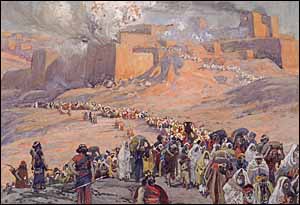 James J. Tissot, 'The Flight of the Prisoners' (c. 1896-1902), gouache on board, 8 15/16 x11 5/8 in, in the Jewish Museum, New York. |
It will help you to understand the historical background of the Exile that so radically shaped the history and character of the people of Israel.
In order to subdue the rebellious peoples of its growing empire, the Assyrians -- and the Babylonians after them -- had a policy of deporting the leaders and artisans from a conquered country, leaving only the poorest. These were often replaced by conquered peoples from other lands (2 Kings 17:24).
|
|
The Assyrian Deportations
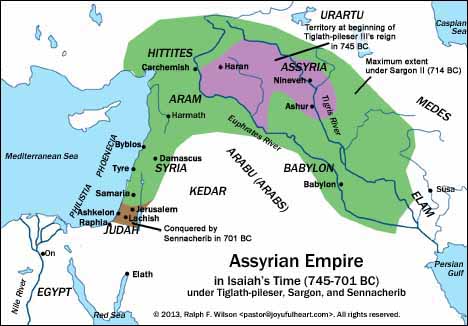 Assyrian Empire in Isaiah's Time (745-701 BC) (larger image) |
When Assyria was in its ascendance under Tiglath Pileser III (745-727 BC), it conquered increasing amounts of the Northern Kingdom, exiling peoples from the area around and north of Galilee in about 730 BC (2 Kings 16:29). A few years later in 720 BC, Tiglath Pileser's successor, Shalmaneser V (727-722 BC), after a three year siege, took the rebellious capital city of Samaria and deported its people to Gozan, on the Harbor River, and in towns belonging to the Medes (2 Kings 17:6).
Judah, too, was threatened by this Assyrian resurgence. In 701, and perhaps again in 688/87 BC, Sennacherib sent forces into Palestine, attacking all the fortified cities of Judah and took them all except for Jerusalem, which was spared (2 Kings 18-19).[319]
Later in the fifth century BC, pressures on Assyria from within Mesopotamia caused the Assyrians to be less involved in Palestine. This left Josiah, king of Judah, able to institute considerable religious reform without interference. Nineveh, capital of Assyria, fell to the Babylonians and their allies in 612 BC.
Babylon Exile
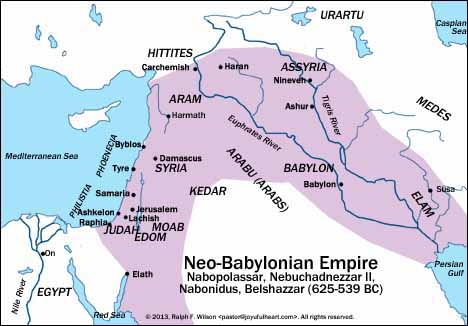 Neo-Babylonian Empire (625-539 BC) (larger image) |
The King of Babylon who ended three centuries of vassalage to Assyria was Nabopolassar (626-605 BC), Nebuchadnezzar's father. Nabopolasser sent his son Nebuchadnezzar west with a large army to end the influence of Egypt over the lands of Syria, Phoenicia, and Philistia. Egypt had allied with Assyria, now in severe decline, having moved their capital from Nineveh to Harran, and then to Carchemish.
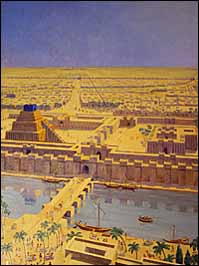 Maurice Bardin (1936), 'View of the City of Babylon' (1936), in the period of Nebuchadnezzar II (604-562 BC), with the Euphrates, Esagila (left), and the Marduk temple (right) in the foreground. following Eckhard Unger's reconstruction. Oil on canvas, 4' x 3', Oriental Institute, University of Chicago. |
At the Battle of Carchemish in 609 BC, the Egyptians and their allies were soundly defeated (Jeremiah 46:2; 2 Chronicles 35:20). Assyria soon ceased to exist. The Babylonians wasted no time in sending the armies of Babylon through Phoenicia, Philistia, and into Judah, which had formerly been under Egyptian control. In 605 BC, Nebuchadnezzar II (605-562 BC) threatened Jerusalem, and exiled to Babylon some of the city's elite and royal families as hostages, including Daniel and his friends, in the first exile. At that time, King Jehoiakim (609-598 BC) became a vassal of Babylon.
Three years later, however, Jehoiakim sensed a weakness in Babylon and rebelled. By the time he died, Babylon was on the march against Jerusalem to put down the rebellion. Johoiakim's successor Jehoiachin (598 BC) reigned for three months until Nebuchadnezzar besieged Jerusalem, and at its surrender looted the temple and took many people into exile to Babylon, the second of three exiles. Nebuchadnezzar put Jehoiachin's uncle, Zedekiah (598-587 BC), on the throne in his place. When Zedekiah rebelled against Babylon, Nebuchadnezzar laid siege to Jerusalem for two years, finally breaking through and destroying the temple and the city, and breaking down the walls. At this time he took to Babylon the remaining articles for service in the temple, and in 587 BC, in the third and final exile, sent those remaining to Babylon. Only a few remained in the land.
The Medes and Persians and a Return from Exile
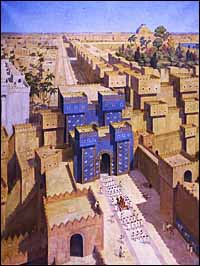 Maurice Bardin, "City of Babylon" (1936), showing the Ishtar Gate, oil, after watercolor by Herbert Anger (1931); Oriental Museum, University of Chicago. |
Jeremiah had prophesied:
"This is what the LORD says: 'When seventy years are completed for Babylon, I will come to you and fulfill my good promise to bring you back to this place.'" (Jeremiah 29:10)
If you count from the first exile in 605 BC, this 70 years was up just about the time that Cyrus II, King of the Medes and Persians, conquered Babylon (539 BC), and subsequently decreed that the Jews could return to Jerusalem and rebuild the temple (Ezra 1). Under Zerubbabel (Jehoiachin's eldest son) and the Prophet Haggai, the temple was rebuilt about 520-515 BC. The city walls, however, were still in disrepair, leaving the Jews weak and subject to their enemies. Later, Ezra (about 458 BC) and Nehemiah (about 445 BC) travelled to Jerusalem to regularize temple worship and to complete the building of the walls.
 Available in book formats: paperback, Kindle, PDF |
Endnote
[319] Probably, many Judeans were deported at this time, though the Old Testament is silent on the matter. Accounts by Sennacherib claim 200,000 people were deported from the region, including Philistia, Tyre, and Sidon.
Copyright © 2025, Ralph F. Wilson. <pastor![]() joyfulheart.com> All rights reserved. A single copy of this article is free. Do not put this on a website. See legal, copyright, and reprint information.
joyfulheart.com> All rights reserved. A single copy of this article is free. Do not put this on a website. See legal, copyright, and reprint information.

